The Space Marine Legions of the First Founding make up the core factions and conflict of the Horus Heresy. In this article, the eleventh in our series, we crack open a dusty tome, blow off the dust of aeons, and look closely at the Sorcerer-Kings of Old Prospero: The Thousand Sons.
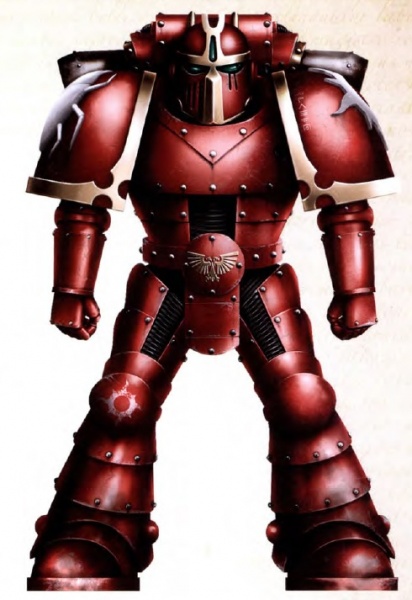
Introduction
“While other Legions walked into infamy at their own choosing, the Thousand Sons were plunged into that state; first by their own pride, second by the treachery of those who they trusted, and third by the Imperium itself…”
The Thousand Sons are not the archetype of a Traitor Legion – they do not throw themselves howling into the foe like the World Eaters, or openly worship the Empyrean in the same way as the Word Bearers. In fact, if not for a few twists of fate, they may never have turned from the Emperor at all.
A Legion composed entirely of Psykers, they stood as a unique fighting force in the nascent Imperium of Man, a dedicated project of the Emperor which eventually fell afoul of the Edict of Nikea, the machinations of the Lord of Change and, ultimately, the Wolves of Fenris.
Background
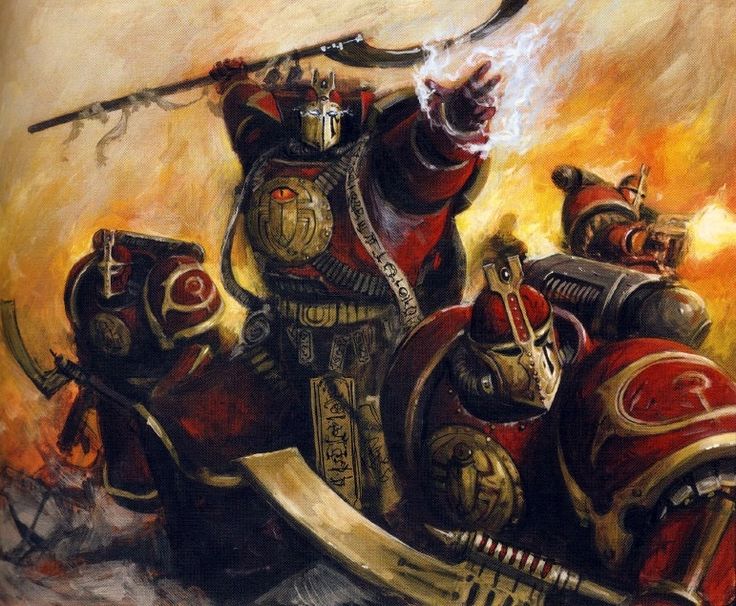
The Thousand Sons initially had a veiled and unclear purpose. They were born during a series of violent warp storms shortly after the conclusion of the Unification Wars, and at the start of the Great Crusade. These potent storms caused panic and upheaval, with shipping disrupted and mutation rife.
The Emperor was – of course – unconcerned by this phenomenon, and instead responded by arranging the founding of key Imperial factions such as the SIlent Sisterhood. Among these were the XV Legion.
The XV began as, frankly, an unremarkable Legion. The only thing which set them apart in these early days was the inexplicable “deliberate and exacting criteria” imposed upon the Legion intake, with “strictures imposed that were beyond that of their fellow Legions.” They only took stable, culturally sophisticated candidates, which meant the Legion was initially very small, and grew very slowly indeed. When one thousand Legionaries were ready, they were inducted as a Legion by the Emperor himself.
As he bade his “Thousand Sons” to rise, the storms broke and abated. A promising omen.
The XV set out on the Crusade, competent and effective, but not remarkable or particularly distinct from their brothers. They won a string of well-received victories against Xenos filth and non-compliant humans, working well with their fellow Astartes, and showing a strong degree of intra-Legion coordination in doing so. However, to be blunt, they did not excel in the same way as – say – the Luna Wolves. Their reputation was for reliable competence, but nothing more.
This changed, around ten years into the Great Crusade. The Legion began to manifest psychic powers – “deluges of bio-kinetic lightning, armour-cracking telekinetic fury, thoughts which razored open minds… it seemed to onlookers as though the designs of the Emperor had at long last begun to bear fruit.”
The careful preparation of Him on Earth had ensured only those with psychic potential had been inducted into the XV, and now their powers finally came to the fore. This proved utterly deadly in the hands of already-puissant transhumans, although earned them suspicion and ire from other Legions. It is whispered even Horus Lupercal himself voiced private concerns to the Emperor – but the Master of Mankind remained silent.
And so it was, until the Flesh Changes began…
First seen on Bezant, when a Legionary named in the records only as “Daleth” was consumed by his powers and turned into a mutated spawn-like husk, slaughtered by his horror-struck brothers. This Flesh Change continued to plague the Legion, with warrior after warrior falling victim to it as the Legion desperately sought some sort of cure, with some forcing themselves into hyper-stasis to prevent mutation. Perhaps the Emperor knew of this risk, but He said nothing. The other Legions had little sympathy for the XV, seeing it as a manifestation of genetic (or philosophical) corruption, the rewards of dangerous sorcery.
Never a large Legion, the Thousand Sons began to panic and get desperate – their Legion had a very real risk of dying out given their low numbers. But they were saved… by the Crimson King of Prospero.
Prospero was “a polished jewel glittering along in the long dark of night.” A world which had achieved ascendancy and perfection,gleaming with beautiful temple-cities and magnificent geological features, benefits of a huge explosion in psychic potential of its inhabitants.
Prospero had one blight – the Psychneuein, parasitic mind-wasps who hunted down living psykers to use as breeding grounds. The people of Prospero, in response to this threat, had largely retreated into Tizca, the City of Light, protected under an aegis of psychic might projected by its inhabitants. In Tizca, Magnus learned his craft.
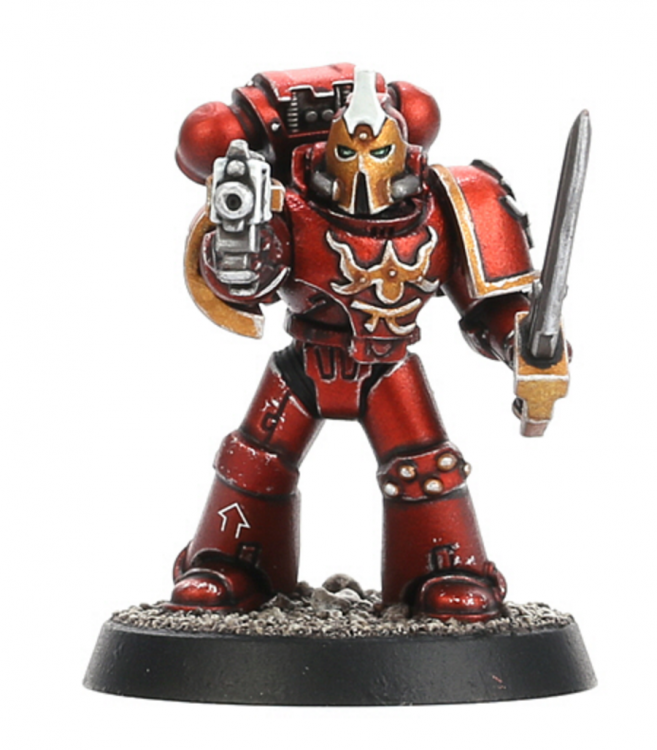
The child from the sky grew – as many of the Primarchs did – astonishing quickly, becoming an enormous, red-skinned giant among men, hungry for scholarship and wisdom. Taught by Amon, he quickly became a master and ascended to the top of Prosperine society, before being found by the Emperor (although some speculate he had known of his Father long before this, connected via their psychic gifts).
When Magnus rejoined his Legion, he found a force riven and ruined by the Flesh Change, with many mutated Legionaries, or others kept in protective stasis vaults. At last, Magnus found he had capable pupils and disciples who could absorb his teachings and walk “the path he saw for Mankind.”
Magnus took command of his Legion, declared Prospero to be their home, and turned his not-inconsiderable efforts into finding a cure to the curse.
A cure was, in time, found. What it was, or how it was obtained, is a mystery – we can only speculate, and given the Heresy which followed, thoughts clearly turn to malevolent entities within the Warp. Whatever Magnus did, it worked, but perhaps cost him more than he could ever have anticipated…
His Legion restored and renewed, he took recruits from Prospero, building up the Five Prosperine Cults and expanding knowledge of psychic powers and the application of this to battle. Under Magnus, the Thousand Sons became hungry for forgotten (and forbidden) lore, a devastating fighting force combining the raw power of a full-strength Legion with unfettered psychic potential.
A true beacon of the Emperor’s Light.
During the Heresy
“For a time, it seemed as though Magnus and the Thousand Sons had begun to shed the suspicions which had shrouded them for decades… Fate, though, is relentless.”
You cannot talk of the Thousand Sons in the Great Heresy without talking of three linked tragedies – the breaching of the Imperial Dungeon, the Council of Nikea, and the Burning of Prospero.

As the Crusade ground on, Magnus and his Legionaries discovered new wonders and forgotten lore, uncovering secrets such as the existence of the Webway, and how entities and intelligences seemed to live within the Warp. Distrust, sadly, grew between the XV and other Legions – particularly the Space Wolves – fuelled by hatred in the wider Imperium for mutants and psykers.
This all came to a head at a great Council, at a planet called Nikaea, where all the factions of the fledgling Imperium of Man were represented – including a significant proportion of the Primarchs attending in person – to debate the use of psychic powers once and for all. The consensus fell against Magnus, and the Emperor ordered in the interests of Imperial Unity, the use of psychic abilities by the Imperium’s military forces was to be generally banned or restricted, save for some limited applications (such as Astropaths or Navigators). The Librarius Project was ended, with the Librariums disbanded, and their acolytes returned to normal line duty.
This had a devastating effect on the Thousand Sons, removing their unique abilities and powers and fettering them in a far greater way than their brother Legions. Magnus obeyed, at first, but soon found himself trying whichever way he could to circumvent the Edict of Nikaea.
After the Conquest of Ullanor and the Great Triumph, the Emperor returned to Terra to pursue his Great Work – the Webway Project, beneath the Imperial Palace.
Magnus, as this Work was ongoing, psychically witnessed the corruption of Horus Lupercal and – ever loyal – tried to warn his father of this unthinkable treachery. Breaching the Edict, he sent his mind through the Empyrean, desperate to warn the Emperor of the impending civil war.
Around the Imperial Palace he found nigh-unbreachable psychic wards and, in a decision which some say cost the Emperor His dreams, bargained with a Warp entity (thought to be Tzeentch itself) to breach the barriers.
This breach caused havoc in the Dungeon, killing thousands of Mechanicus Adepts and ruining the Emperor’s work. The end result was a direct passage into the Imperial Palace for all the horrors of the Warp, and the end of the Webway Project. The War in the Webway then began, which ultimately bled the Ten Thousand and the Silent Sisterhood dry.
The Emperor was, of course, furious at Magnus’ direct violation of the Edict, not to mention the destruction of the centuries-long efforts He had worked on in the Webway Project. He sent His Executioner, Leman Russ, with an honour guard (the Censure Host), to seize Magnus from Prospero and escort the fallen Primarch to Terra for judgement.
As the Censure Host prepared itself to depart, Horus (by now under the sway of the Ruinous Powers), dripped poisoned words into Russ’ ears, enraging and stirring up his hatred of Magnus, whipping the Primarch of the Space Wolves into a murderous rage. Misled and misguided, Russ used the Censure Host instead as an invasion force, arriving at Prospero to take Magnus dead or alive.
The resulting battle is infamous – the Fall of Prospero, or the Burning of Prospero. Tizca, a jewel in the crown of the Imperium, was utterly flattened by the Censure Host, the Thousand Sons all but destroyed, and Magnus broken over Russ’ knee. Magnus, in desperation, pledged himself to Tzeentch to save his Legion and his people – the result was Prospero being transported into the Eye of Terror and becoming a Daemon World.
When the Flesh Change then returned in full force, Ahriman of the Thousand Sons desperately tried to help them with an incantation, the Rubric of Ahriman. The dreadful result turned most of them into dust and ash, their spirits trapped into their armour, turned into grim automatons.
Such are the rewards of Heresy.
The Thousand Sons, weakened and scattered, played little part in the battles which followed, but in the 41st Millenium are still a force to be reckoned with, with Magnus a mighty Daemon Primarch still hunting down the Space Wolves wherever he can.
Legion Special Rules
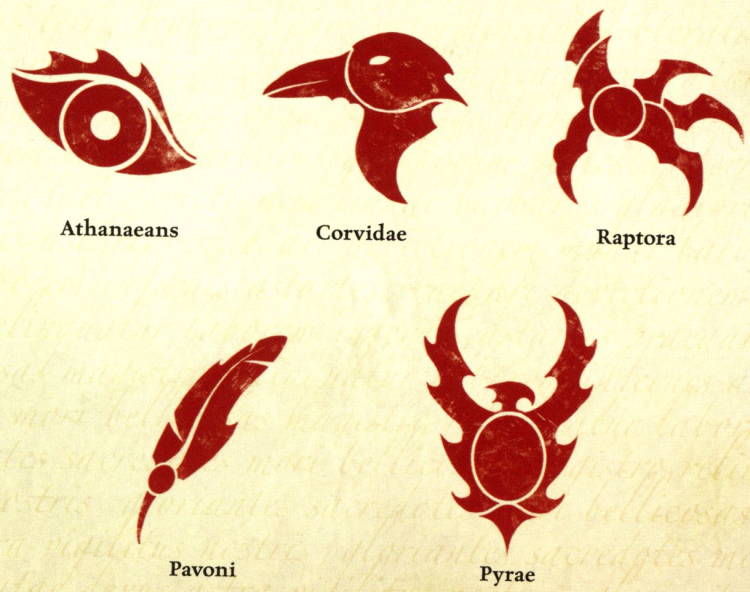
The Thousand Sons are, at the time of writing, probably the most complex of the Legiones Astartes in terms of the special rules layered on top of the basic Legion army list. Below we go through these but, be warned, the rules are fairly complex.
Please also note that the Thousand Sons have been heavily FAQ’d since their release in Book 7: Inferno. The below accounts for this as much as possible.
The Thousand Sons have the following special rules on the tabletop:
- Covenant of Sorcerors: When creating a Thousand Sons Detachment, you must determine the Warlord as the first step. They must be an Independent Character with Mastery Level 1 (at least), and have the highest available Leadership value in the force.
- Prosperine Lore: Psykers within the Thousand Sons have access to all psychic disciplines, save Malefic Daemonology. Any Independent Character HQ who isn’t already a Psyker can buy Mastery Level 1 for +20 pts, and swap a power weapon for a force weapon for +5 pts.
- Signs & Portents: If a Thousand Sons unit suffers wounds as a result of a Perils of the Warp test, the Thousand Sons player must take a Pinning test for every unit in the force with the Legiones Astartes (Thousand Sons) special rule. If all the Independent Characters in a Thousand Sons Detachment are slain, all surviving units in the Detachment suffer a permanent -1 Ld for the rest of the game and cannot make Sweeping Advances.
These rules are pretty straightforward – you need a psychic leader, and can upgrade units to have this. Avoid Perils checks, and avoid losing all your HQ!
The Cult Arcana
This is where the complexity sets in, and so I have split this rule out into its own sub-section.
The psychic powers of the Thousand Sons are based on Cults. This means:
- For each unit with the Cult Arcana rule, the controlling player must select a Cult Arcana when making the army list, with the chosen unit getting the benefit of that Cult.
- Compulsory Troops must use the same Cult as the army’s Warlord, or for Allies the same Cult as the Detachment’s compulsory HQ.
- Each Cult Arcana has a psychic discipline associated with it. A Cult unit has to draw powers only from that matching discipline (with no Santic Daemonology).
The Cults are as follows:
- Pavoni (Biomancy) – Quickblood: +1” to Run and Sweeping Advance distances.
- Raptora (Telekinesis) – Kine Shields: the unit gains a 6++ Invulnerable Save, or improves an existing Invulnerable Save by +1 to a maximum of 3++.
- Corvidae (Divination) – Precognitive Strike: Reroll To Hit rolls of 1 when making shooting attacks if you remained stationary in the Movement phase.
- Athanean (Telepathy) – Mental Fortitude: Immunity to Fear and gain Adamantium Will.
- Pyrae (Pyromancy) – Ashen Blow: Gain Hammer of Wrath. If the unit already has it, it inflicts 2 Hammer of Wrath attacks rather than 1 when it charges.
Legion Special Equipment & Upgrades
The Thousand Sons have access to a number of esoteric units and upgrades, befitting their Legion:
- Thousand Sons Praetors: Thousand Sons Praetors are Psykers and must be purchased 1-3 Mastery Levels for +25 pts per level. They can upgrade any power weapon to a force weapon for +5 pts.
- Thousand Sons Veteran Tactical Squads & Terminator Squads: These squads can be upgraded to have the Brotherhood of Psykers rule with Mastery Level 1 for +25 pts per squad.
- Arcane Litanies (One Use): Ignore the first Perils of the Warp test the unit is subject to. Any Independent Character with Legiones Astartes (Thousand Sons) with a Mastery Level of at least 1 can take this for +10 pts.
- Aether-fire Cannon: A modified plasma weapon fuelled by occult magicks, this is a 26” S 7 AP 2 Heavy 1 3” Blast Soul Blaze, Gets Hot! upgrade for a Plasma Cannon for any model for +10 pts. All Plasma Cannons must be identically upgraded within a unit.
- Asphyx Shells: Bolter rounds loaded with psycho-reactive toxins. Weapons with these gain Shred, and Thousand Sons Independent Characters can buy this for +10 pts to upgrade bolt weapons. Terminators and Veteran squads can buy this for +20 pts per squad. Rotor cannon Tactical Support Squads can buy this for +25 pts per squad.
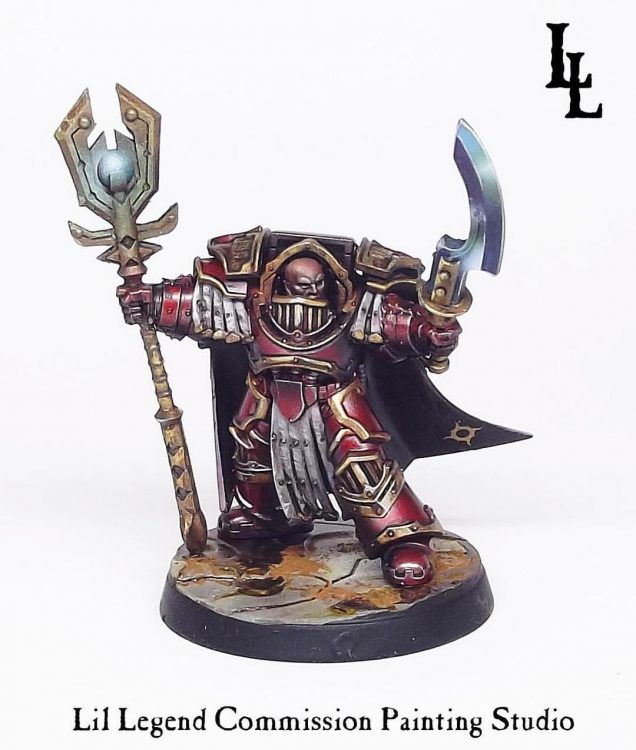
As an aside, Asphyx Shells are not too bad, but fairly expensive for what you get. Aether-fire Cannons are complete garbage sadly – additional points on top of an already expensive Plasma Cannon for Soul Blaze, which is barely worth 1 pt let alone 10.
Legion Rites of War
The Thousand Sons have two unique Rites of War – The Axis of Dissolution and The Guard of the Crimson King.
The Axis of Dissolution
This Rite of War is intended to replicate a coordinated ambush, where the enemy is impaled upon its own attack and “brutally bled when forced to retreat”, exploiting the preternatural coordination of the Thousand Sons to do this.
To take this Rite, you must use Troops units which are their maximum possible squad size (e.g. 20 man Tactical Squads), and cannot use more Tanks or Flyers than Infantry. This can be quite a significant restriction as it balloons your Troops points spend to essentially the maximum possible, and means you must account for relatively unwieldy units.
The benefits are The Alembic of Adamant, which means Legiones Astartes (Thousand Sons) automatically pass any Morale or Pinning tests if they are within 6” of an objective – great, assuming the game has objectives. You also get The Caustic of Grace, which gives you BS 2 Overwatch, and The Transition of Vitriol, which allows you to re-roll To Hit and To Wound rolls against enemies who are Falling Back if you are Legiones Astartes (Thousand Sons).
This is… OK. BS 2 Overwatch isn’t bad – particularly on a max-sized squad – but it is situational and not something I would consider worth building an army around for a Rite of War (contrasted with, say, Solar Auxilia who get it for “free”). Re-rolls against units which are Falling Back is, unfortunately, pretty bad – generally those units are severely damaged and not priority targets anyway, and very often units don’t end up Falling Back, as they are subject to a Sweeping Advance which wipes them all out.
All in all, an average to low quality Rite of War, which has cool fluff but isn’t going to be the “go-to”. In terms of power level, it is also laughably outshined by the other one, which we go through below.
The Guard of the Crimson King
Anyone who follows 30k “meta” (such as it is) will know about this Rite – it has caused many a gnashing of teeth online, particularly when Inferno was released. This is a Rite designed to emulate what happened when Magnus himself took the field and broke entire worlds.
To take it, you must have either a ML 3 Praetor, Ahriman or Magnus as your Warlord (given you will usually have an ML 3 Praetor anyway, this is fine), you cannot have more Vehicles then Legiones Astartes (Thousand Sons) (fine) and you cannot take Allies or Fortifications (fine). Generally this means, to start with, the restrictions on this Rite are fairly minimal. So what do you get?
- Astral Warfare – when you generate a Warp Charge at the start of the Psychic Phase, you can (if you want) roll twice and pick the highest. This is good, but actually can be counter-productive as you’ll hand your opponent (who will inevitably have fewer Warp Charge dice) more dice.
- Wreathed in Lightning, they Rend the Veil – a wordy rule which gives Terminator-armoured units and Magnus Deep Strike using Teleport, giving them Fear on the turn they arrive and allowing them to re-roll failed invulnerable saves of 1 until their controlling player’s next turn. When you consider that Sekhmet can get 3++ invulnerable saves… that is really rather good.
- The Initiates of the Scarab – Sekhmet must be compulsory Troops, and can then be taken as optional Troops. Given these are, point for point, some of the best units in the game, this is really rather nice. Finally, you have The Bidding of the Crimson King, allowing Magnus to be selected as a Compulsory HQ and not count as a Lord of War.
Taken together, the potential for abuse in this is astronomical. Magnus, an additional Lord of War, and Sekhmet with re-rollable 1s on invulnerable saves when they use Deep Strike to get precisely into position… ugh. It is, quite simply, one of the most potent Rites in the game. Use with caution, and don’t be surprised if you get your list amended if you try to take this to an event and be exploitative about it.
Legion Special Units
The Thousand Sons benefit from a range of unique special units, including Zhao-Arkhadian Castellax and the formidable Sekhmet.
Osiron Dreadnought (Variant Contemptor)
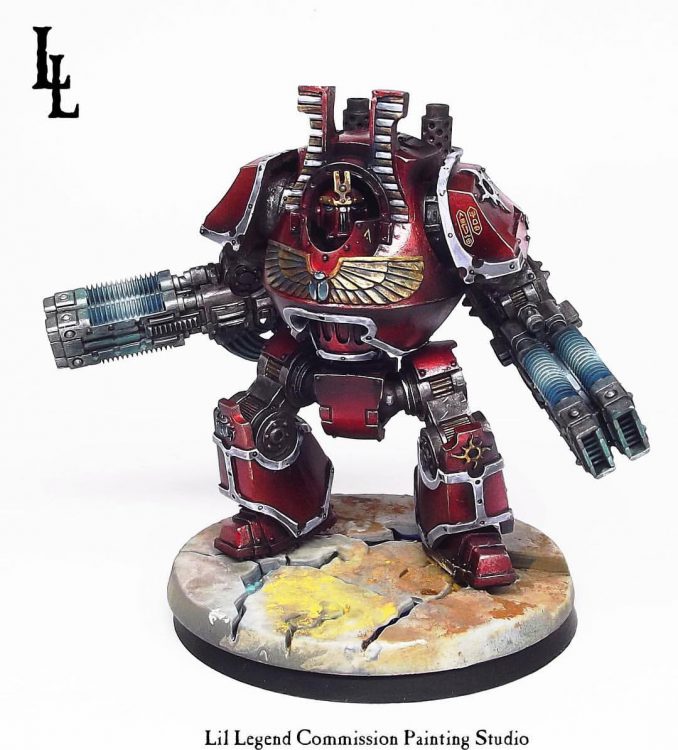
A damn fine looking model from Forge World, and a very interesting unit on the tabletop. The Osiron is an upgrade to an existing Contemptor Dreadnought, costing +50pts, which gives them all the options a standard Contemptor can take (so very versatile in and of itself), along with a number of additional rules.
Chief among these is it becomes ML1 (a psyker Contemptor!) and can take Telekinesis, Telepathy, Pyromancy or Divination, and gains Adamantium Will. It can also take a Force Blade with a combi-bolter with Asphyx shells – which is a DCCW with Force.
Overall, this is OK but quite pricy for what you get. You should be trying to use this as a force multiplier, and think carefully about what powers you might want to use it for. Force, even if the only thing it can cast if it decides to use it that turn, is not to be sniffed at – there is precious little Eternal Warrior in the Heresy, but many things which are T6 or above (particularly amongst Daemons or the Mechanicum) which will resist a S10 hit. Throw these into those kinds of units and you can do some serious work!
Overall not a game-winner, but a great fluffy unit that is well worth taking for the model alone!
Castellax-Achea Battle-Automata Maniple
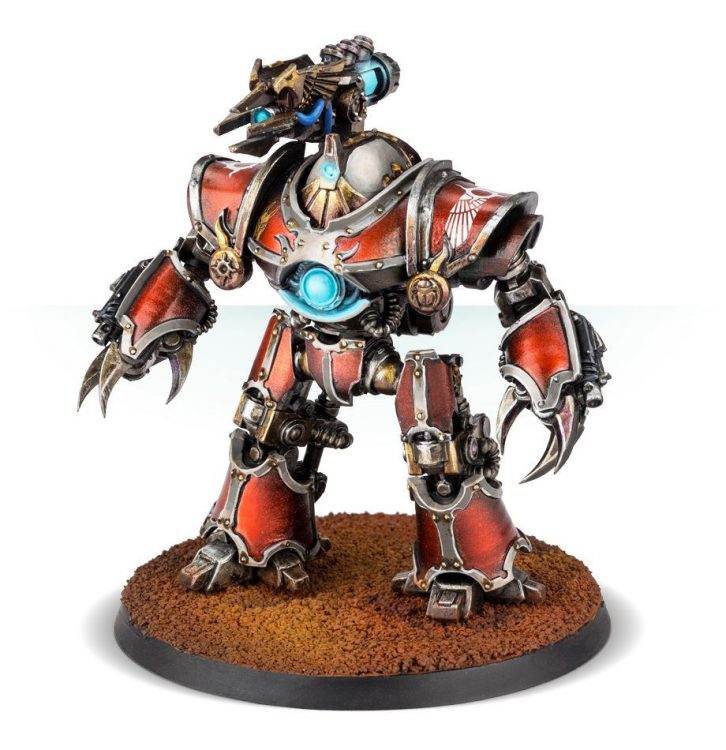
First off, I just need to comment on the model for these – it is gorgeous. A great bit of work by Forge World. These come with a pair of power fists with Asphyx bolters and a Mauler pattern bolt cannon with Aspyhx shells – a fairly standard loadout for a Castellax, augmented by the Shred rule. For 135 pts, this is quite good. They can then take an Aether-fire Cannon for 15 pts (OK I guess – 150 pts is not a bad platform for a Plasma Cannon).
They also have a Refractor Field, and a Psi-Control Matrix, which gives them a large number of special rules.
The Psi-control Matrix replaces a cybernetica cortex and is, according to some, “pure tech-blasphemy.” You need to keep a unit with a psychic ML of 1 or more, and the Legiones Astartes (Thousand Sons) special rule within 24” of these Castellax, or they cannot Charge, Run or make Sweeping Advance moves.
It also allows them to fire three weapons in the Shooting Phase, and the Thousand Sons player can cast Witchfire and Malediction powers through a Castellax-Achea if it is within 12” of the casting unit – which can be interesting for drawing line of sight.
Finally, if a Perils of the Warp (friend or foe) occurs within 12” of the Castellax-Achea, roll a separate Leadership test for the unit (on Ld 7). If it fails, it suffers D6 wounds with no armour or invulnerable saves allowed, and if they are destroyed they explode with a maximum blast radius (normally they only explode when they die on a roll of a 6 – Str 4 Ap – hit within D6”).
This is… a mixed bag. The Perils thing is pretty bloody devastating, as even-odds you’re going to lose enough wounds to kill a Castellax! I think these are cool units, are cost-effective given you don’t need a Praevian or similar to babysit them, and they can put out some decent anti-Infantry firepower with the Aspyhx shells.
2 or 3 of these can find their way into most forces I would say. Just don’t base your plan around them.
Sekhmet Terminator Cabal
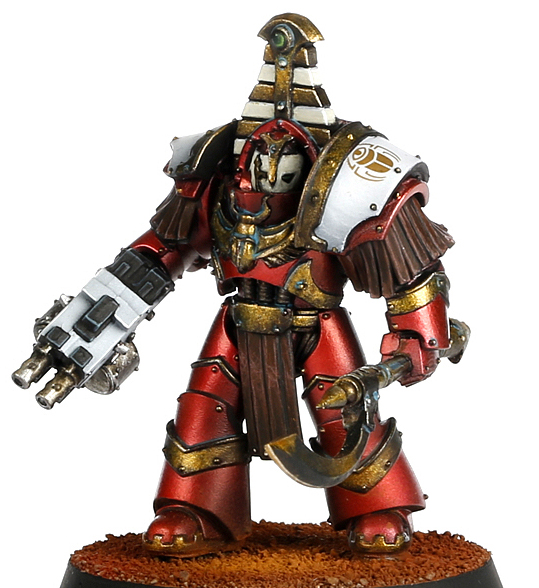
Phew… these are the units which make people lose their minds. Sekhmet are 255 pts for 5, with 2 Wounds each and they can be Cataphractii or Tartaros. They come with a Force weapon and a Combi-bolter with Asphyx shells, along with Stubborn and ML 2 Brotherhood of Psykers, along with Implacable Advance.
Contrast that with, say, the Varangr, and the points-to-punch ratio is very clear. These are incredibly cheap at +35 pts each, and can take Fists or Chainfists for +5/+10pts, and Combi-weapons for +5pts (which keep Asphyx shells!). That is already quite a versatile unit with 2W, before the psychic shenanigans come into play. I would have costed these at closer to 300 base.
Raptora is the obvious one – +1 Invulnerable saves is amazing. Pavoni, for Biomancy, also has its place, as does Corvidae for Divination. The combination of powers and Terminators can be very formidable, and that is before they are included in the Guard of the Crimson King.
There is not much else to really be said about these units. They are excellent all rounders, and can be hurled into the thick of it and survive with their multiple wounds.
All in all, these are some of the best units in the game in terms of points to value ratio. Five of them can do serious work in any Thousand Sons force. And the models look brilliant!
Khenetai Occult Blade Cabal
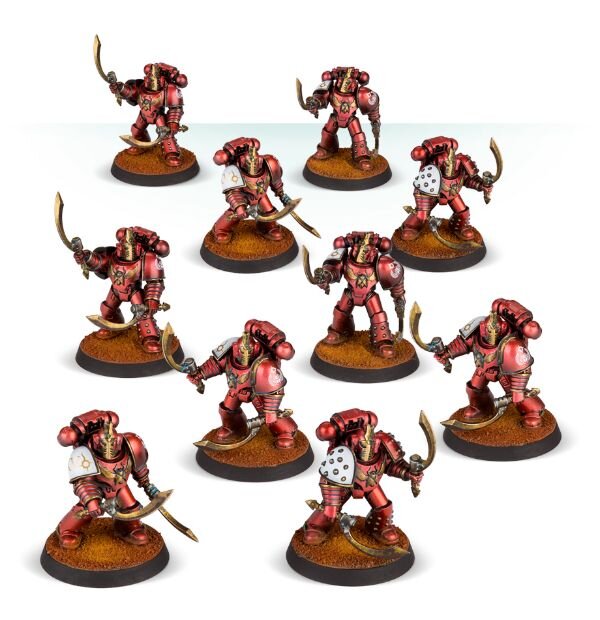
Khenetai are one of those units which I want to see more of, as I think they are really cool and I love the concept of their rules (and the models are amazing!). However, they are expensive and basic T4/3+ Marines, which makes them not particularly survivable…
Coming in at 185 pts for 5, with twin force swords, ML 1 and Mindsong of Blades, they are a melee-focused squad with +25 pts per additional Blade, and WS 5 (but only 1 attack Base for the standard Blades).
The Mindsong of Blades rule is their unique flair – depending on the number of models in the squad, a different bonus is afforded. 9-10 is +2 Attacks +1 WS, 4-8 is +1 Attack +1 WS, 0-3 is +1 Attack. While it isn’t explicit, I would generally check at their Initiative step for where they are with the bonus.
In practice this means they are minimum 3 A base and usually WS 6 – quite good – but this doesn’t make up for their relatively high base cost, lack of an Invulnerable save unless they go Raptora, and basic 3+ saves.
If you take a squad of 10, for the maximum bonus, it is unlikely they will all reach combat unless you invest in (say) a Land Raider – and then you are looking at 500+ pt unit, which degrades sharply as it takes casualties. Perhaps they could shine in Zone Mortalis or Centurion. Otherwise I fear they will just be a cool painting project or used for Sergeants and not much else.
Ammitara Occult Intercession Cabal
Try saying this squad name after a couple of drinks! The Intercession Cabal are, I am afraid, very much like the Khenetai – an awesome concept (albeit without models), which I rarely see on the tabletop as they just don’t seem to have the needed punch.
They are Recon marines with BS 5 (so 4+ saves), coming in at 135 pts for 5, with Shroud bombs and Sniper rifles. They also have Stealth, Infiltrate, Scout, Move Through Cover and ML 1 with a unique psychic power to use – Mind Killer.
Mind Killer is Warp Charge 2, placing a blessing on the Intercession Cabal which allows them to re-roll Hits and Wounds, and gives their weapons Ignores Cover.
All of this, on paper, seems really quite good! So what is the problem?
Well, the problem I would say is the Sniper rifles… you can take a Melta Gun or Plasma Gun per 5 men, but Sniper rifles on their own are really not brilliant. Even boltguns with Aspyhx shells may have been better here.
I think these maybe get a bad rap as there are no official models for them (yet), but I just can’t help but think by the time you have lined them up and cast Mind Killer, that the resulting 5 Sniper shots is rubbish for all that effort and investment. A real shame.
Legion Special Characters
Ahzek Ahriman – The Chief Librarian of the Thousand Sons, The Enduring Son
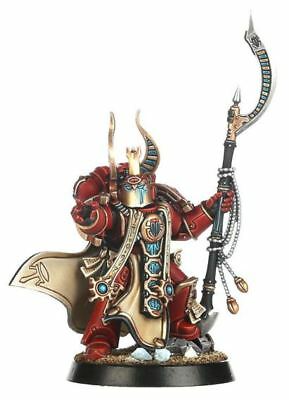
Ahriman needs no introduction – he is still a serious player in the 41st Millenium and an iconic character on the Chaos side. A Terran, he and his twin brother were among the first recruits into the Thousand Sons. In battle, Ahriman was often a lynchpin, coordinating the Thousand Sons and foreseeing the actions of the enemy to win time and time again. His arrogance, however, was sadly his ultimate undoing.
On the tabletop he is a Praetor with ML 4(!), generating powers from Divination. He has a Master-crafted Bolt Pistol with Asphyx shells, a Master-crafted force axe, a 4++ invulnerable save, free Arcane Litanies, and some unique rules.
Arhiman is Marked by Dark Fates, which means in campaigns he can re-roll injury rolls (so more or less a “non-rule” outside of very specific circumstances). Any Command squad he takes can be upgraded to be Ahriman’s Cabal, giving them Ml 2 for +50 pts, the Corvidae cult and Divination powers.
If he is the Warlord, he gains Pattern of Fates, giving up to 3 units with the Legiones Astartes (Thousand Sons) rule Scout before you deploy your army.
Overall, a solid choice at 225 pts – expensive, but he has a lot of Divination utility and, given his statline, can fight on the front lines well enough to not need to hide at the back of the army.
Magistus Amon – The Hidden One, Tutor of Magnus
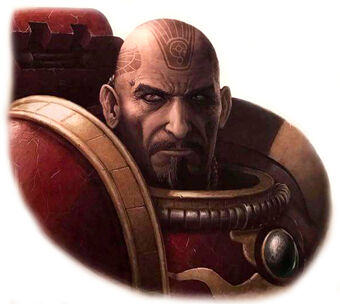
Ben Kingsley – I mean, sorry, Magistus Amon – was the equerry and emissary of Magnus the Red during the Great Crusade, and it is said that he was Magnus’ original tutor in sorcery. On the tabletop, Amon is a great support character.
He is a Praetor-level statline for 170 pts, with a 2+ save (but no Invulnerable save), a Master-crafted Force sword, an Archaeotech pistol, and free Arcane Litanies.
He has a plethora of special rules, including ML 3 (Divination/Telepathy) and Infiltrate. He also has two Cults – Corvidae & Athanean.
In terms of unique rules, Amon wears The Armour of Shades, which gives him a 2+ armour save and 4+ cover save even in the open, or +2 bonus to any other cover save (so, usually a 2+ or 3+ in practice). If he joins a unit, they gain a 6+ save in the open or +1 bonus to any other cover saves. A very nice little item.
He then has The Dust of the Devourers, kept within his special staff – the remains of slain Psychneuein. Once per game in the Assault phase, instead of making normal attacks, he can choose to unleash this Dust. This inflicts D6 automatic hits on whatever Amon is fighting if it is 5 models or fewer, or 2D6 if it is 6+ models. These are Poisoned (4+), Concussive, AP 4. Hardly game winning, but fun.
Amon was the master of the Thousand Son’s external intelligence network, and benefits from Hidden Servants & Secret Scryings, allowing his controlling player to re-roll Seize the Initiative. Enemy units cannot Outflank within 24” of Amon, unless arriving on their own table edge, or Deep Strike within 12” of him.
If he is the Warlord, he has Lord of Hidden Paths, allowing you to Outflank a single non Flyer/Super-Heavy unit, which can be on a specific turn (chosen in secret after deployment but before the game begins) after Turn 1. No roll is then needed.
Overall, not bad in a scrap but definitely the kind of HQ you build your force around, to deny Outflanks and pull your own units where you need them.
Magnus the Red – The Sorceror of Prospero, The Crimson King, The Logos Maxima, The Cyclopean Giant
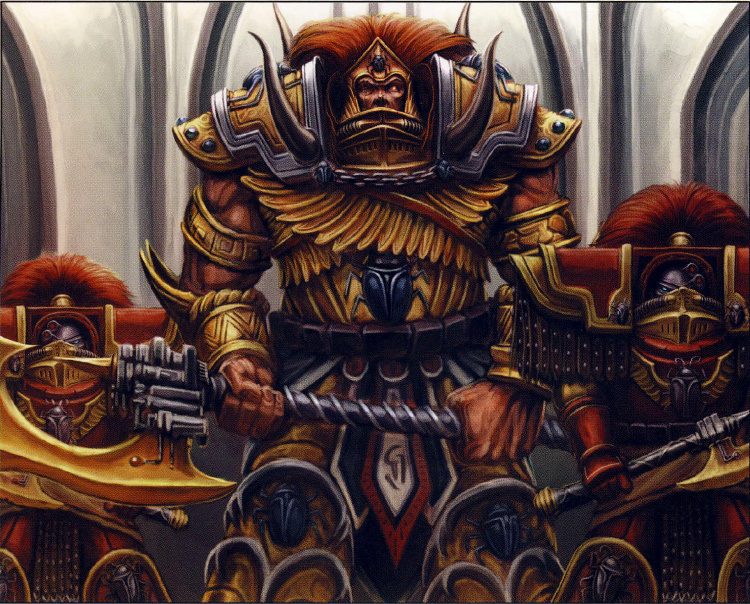
Magnus the Red was unique among the Primarchs as a psychic force second only to his father, the Emperor of Mankind. He led his people on Prospero into a glorious utopia, before it was burned by his brother Russ. Magnus fought in battle like a god of myth, wreathed in fire and unmaking mortal armies with a glance and a gesture.
On the tabletop, Magnus’ current rules can be found in the Horus Heresy FAQ. He has been toned down a bit since he was initially released!
Magnus weighs in at a hefty 495 pts, with Primarch stats across the board, save for a boosted WS 7 and S 7. He also has Arcane Litanies.
He is the Sire of the Thousand Sons, giving Fearless to any unit he joins. All Legiones Astartes (Thousand Sons) in his army can use his Ld 10 for Morale and Pinning tests, and for any Leadership tests taken due to psychic powers – a nice bonus. When Magnus is the Wartlord, all Reserve rolls for the Thousand Sons player can be re-rolled.
Sekhmet and Legion Terminators can be Troops if Magnus if the Warlord, with no restriction owing to Cult Arcana.
Magnus is the Arch-Sorceror, with a terrifying ML of 5(!), and he harnesses Warp Charges on a 3+. You must roll 3 or more 6s on the charge dice to cause Magnus to take a Perils of the Warp, and he re-rolls “1s” on the Perils of the Warp table – so you won’t get rid of him easily that way! He randomly generates 5 powers from Telekinesis, Pyromancy, Divination, Telepathy, Sanctic Daemonology and Biomancy. In this, he has The Eye of the Crimson King, meaning all models with range of any power he is casting (save those in Transports or Buildings) are considered to be within line of sight, and he has Ignores Cover on these attacks.
The Crimson King also has a Phantasmal Aura, meaning any attacks targeting him or an Infantry unit he has joined has -1 to Hit (maximum 6+), and +1 to Scatter on any Barrage weapons targeting him/his unit.
So, what does he then wear and wield? He has The Horned Raiment, giving him a 2+/4++ and reduces wounds caused by Destroyer weapons by 1. He then has The Blade of Ahn-Nunurta, which is +2 S AP 1 Force, making him rip through Monstrous Creatures and able to take on most Vehicles (S 9 total). Magnus also has a ranged weapon – the Psyfire Sepenta, which is 15” S 8 AP 2 Soul Blase Assault D3 – this is a nice bonus in a pinch, particularly with S 8 for Instant Death.
So, we then come to his big upgrade, which can be bought for a significant +175 pts – The Unrestrained Might of the Crimson King. This upgrade (making him cost nearly 700 pts!) gives him Infernal Bargain and the mighty Mind Wrath.
Infernal Bargain allows Magnus to cancel the results of a single Perils of the Warp once/game anywhere on the table (pretty good, given the downsides of failing these for the Thousand Sons). Mind Wrath is a power which Magnus can declare when using a Witchfire power. The power in question has its Warp Charge cost increased by +2. However, if the power is manifested, you add D6 to any listed Strength value (up to 10), and double its range.
The last ability is what was nerfed down big time from the Inferno book – it used to be 11+ Strength made it Strength D, allowing Magnus to drop down and sling Nova powers at Str D around the table. Now it is still very strong, but not as outrageous as it was. It also used to be free.
Overall, Magnus is frankly a powerhouse. He combines all the raw offense of a Primarch with the ability to cast up to 5 powers a turn to help his allies and hinder his foes. He is a real force to be reckoned with, albeit among the most expensive Primarchs out there after the FAQ. I would say he is no longer the game-breaker he once was post-FAQ, but he will certainly change any game he’s in.
Sample Army List
I’ve never played psychic heavy armies, so you may have to take the below list with a pinch of salt – I think it would be fun though, and keeps the resin to a minimum (Sekhmet and then an Anvillus).
This force doesn’t use a Rite at this points level, but you could easily segue into Guard of the Crimson King or Pride of the Legion. It also uses a Command Squad, which is unusual! I have chosen Raptora for the Cult Arcana, for the Invulnerable Saves, but frankly you could make a case for Corvidae or one of the others too.
Rite of War – None
Cult Arcana – Raptora (for all units)
- HQ – Praetor with Tartaros Terminator Armour, Paragon Blade, ML 3, Arcane Litanies
- Command – Command Squad with x4 Tartaros Terminators, x2 Chainfists, with a Land Raider Proteus with Dozer Blade + Armoured Ceramite
- Elites – x5 Sekhmet Terminators with x2 Chainfists
- Troops – x10 Tactical Squad with Combat Weapons, Artificer/Power Fist, Rhino with Dozer Blade
- Troops – x15 Tactical Squad with Combat Weapons, Artificer/Power Fist
- Fast Attack – Anvillus Pattern Drop Pod
This list is leaning towards fluff, and is very small. It uses a pair of hard hitting Terminator units to do the bulk of the legwork, with the Land Raider and Anvillus designed to put hard T1 pressure on the enemy.
The problem is that it’s only backed up with Tactical Squads, which means at this points level it might suffer – at 2,000 pts I would be adding some ranged firepower like a Deredeo and then perhaps a Cortus, or some sort of support squad or Sicaran.
Alternatively, switch this list at 1,500 to Pride of the Legion, drop the Tactical Squads, add another Terminator Squad as the second Troops (with the Sekhmet), and then add units to taste.
Conclusion
The Sorcerers of Prospero are a potent witch-breed, and Magnus has a tragic story with his fall from grace. This makes for a compelling force, with amazing modelling opportunities and a gorgeous paint scheme on the tabletop. The downsides are that you have to engage a lot with the Psychic Phase, which can add complexity, but allows for some very fun combinations!
Next up, we turn our mind to the shadows and the umbral gloom of Deliverance… the Raven Guard!
“All is Dust!”


